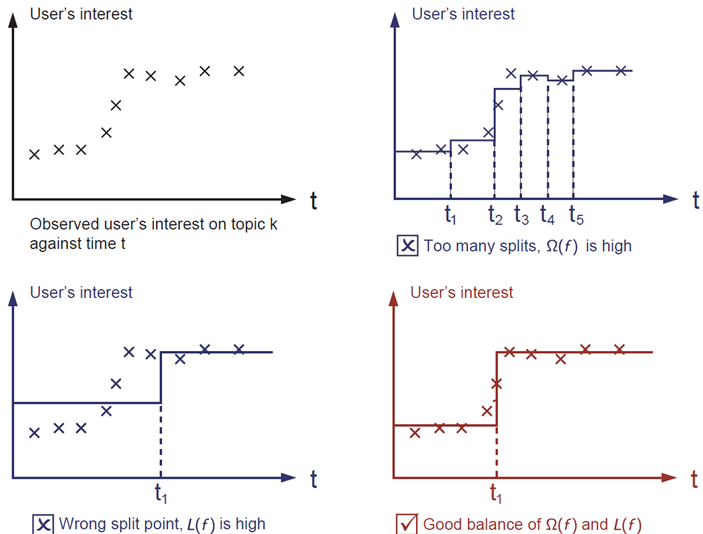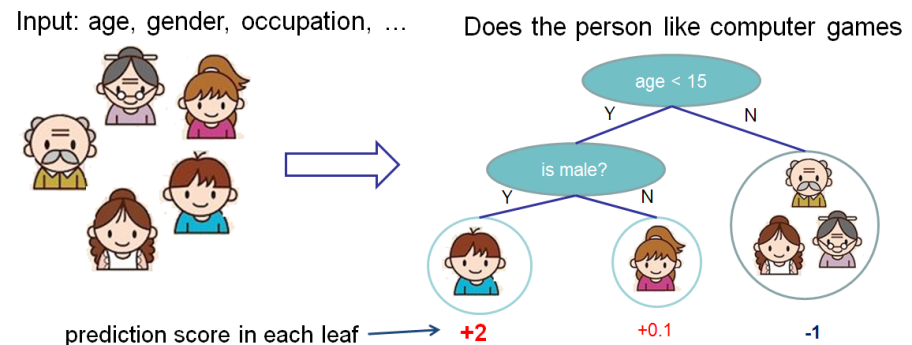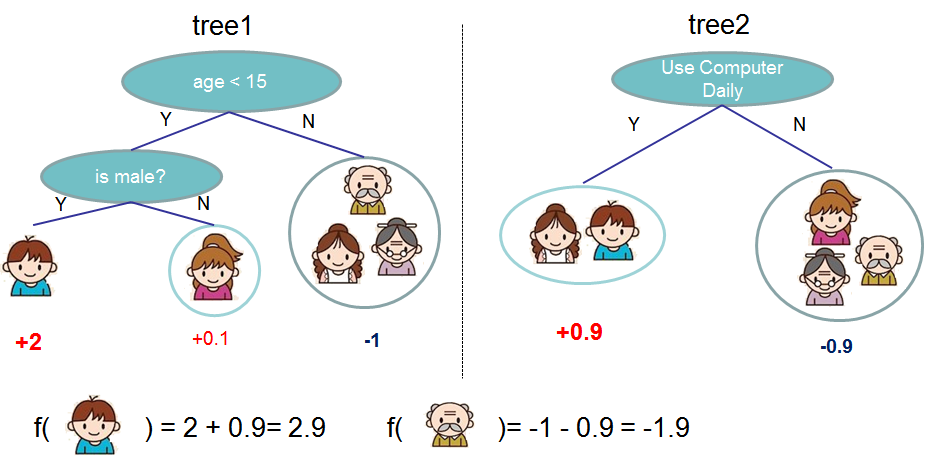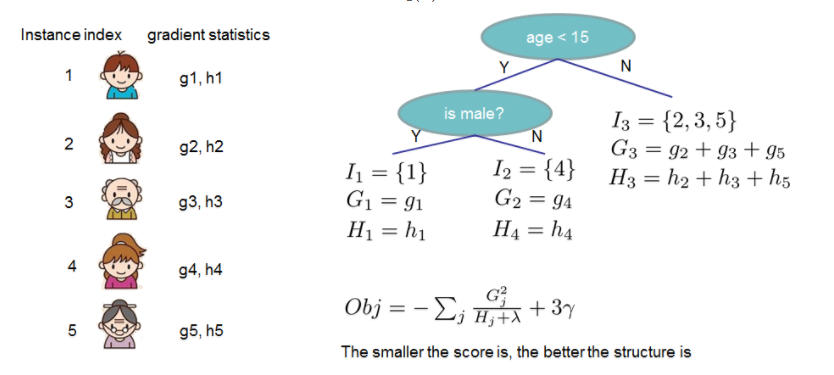[翻译] 提升树算法的介绍(Introduction to Boosted Trees)
[翻译] 提升树算法的介绍(Introduction to Boosted Trees)
1. 有监督学习的要素
XGBoost 适用于有监督学习问题。在此类问题中,我们使用多特征的训练数据集 \(x_i\) 去预测一个目标变量 \(y_i\) 。在专门学习树模型前,我们先回顾一下有监督学习的基本要素。
Elements of Supervised Learning
XGBoost is used for supervised learning problems, where we use the training data (with multiple features) \(x_i\) to predict a target variable \(y_i\). Before we learn about trees specifically, let us start by reviewing the basic elements in supervised learning.
1.1 模型和参数
有监督学习的模型通常指这样的数学结构:预测值 \(y_i\) 是由给定输入值 \(x_i\) 决定的。一个常见的例子是线性模型,其中预测值 \(\hat{y}_i=\sum_j \theta_jx_{ij}\) 是一个对输入特征值的加权线性组合。这个预测值可以有不同的解释,这取决于任务是回归还是分类。例如,在逻辑回归中,可通过预测值的逻辑变换获得样本被归为正面类别的概率;当我们需要将输出进行排序时,预测值也可作为一个排序得分值。
参数是我们需要从数据中学习得到的非确定部分。在线性回归问题中,参数就是系数 \(\theta\)。我们通常用 \(\theta\) 代表参数(事实上模型中有许多参数,这里只是粗浅的定义一下)。
Model and Parameters
The model in supervised learning usually refers to the mathematical structure of by which the prediction \(y_i\) is made from the input \(x_i\). A common example is a linear model, where the prediction is given as \(\hat{y}_i=\sum_j \theta_jx_{ij}\), a linear combination of weighted input features. The prediction value can have different interpretations, depending on the task, i.e., regression or classification. For example, it can be logistic transformed to get the probability of positive class in logistic regression, and it can also be used as a ranking score when we want to rank the outputs.
The parameters are the undetermined part that we need to learn from data. In linear regression problems, the parameters are the coefficients θ. Usually we will use θ to denote the parameters (there are many parameters in a model, our definition here is sloppy).
1.2 目标函数:训练损失+正则项
通过谨慎地选则 \(y_i\),我们可以表达各种各样的任务,比如回归、分类、排序。训练模型意味着要寻求最佳参数 \(\theta\) 使得能够最好地拟合训练数据 \(x_i\) 和标签 \(y_i\)。为了训练模型,我们需要定义目标函数来衡量这个模型拟合数据的效果有多好。
目标函数的一个显著特征是,它由训练损失和正则项两个部分组成:
\[obj(\theta)=L(\theta)+\Omega(\theta)\]
式中 \(L\) 是训练损失函数,\(\Omega\) 是正则项。训练损失函数衡量的是模型在该训练数据集上的预测能力。\(L\) 通常选择均方误差,公式如下:
\[L(\theta) = \sum_i (y_i - \hat y_i)^2\]
另一个常用的损失函数是逻辑损失(logistic loss),被用于逻辑回归问题:
\[L(\theta)=\sum_i[y_i\ln(1+e^{-\hat y_i})+(1-y_i)ln(1+e^{\hat y_i})]\]
人们通常会忘记加正则项。实际上,正则项能够控制模型的复杂度,这有助于避免过拟合问题。这听起来有点抽象。让我们考虑下图中的这个问题:对于左上角图片中给出的输入数据,要求直观地给出一个阶梯函数的拟合结果,三个图中哪个方案的拟合效果最好?

正确答案已用红色标出了。你是否能够直观地感觉出这是一个合理的拟合结果?一般性的原则就是,我们希望得到一个既简单又具备预测能力的模型。在机器学习领域,这两者之间的折衷也被称为偏差-方差权衡(bias-variance tradeoff)。
Objective Function: Training Loss + Regularization
With judicious choices for yi, we may express a variety of tasks, such as regression, classification, and ranking. The task of training the model amounts to finding the best parameters θ that best fit the training data xi and labels yi. In order to train the model, we need to define the objective function to measure how well the model fit the training data.
A salient characteristic of objective functions is that they consist two parts: training loss and regularization term:
\[obj(\theta)=L(\theta)+\Omega(\theta)\]where Lis the training loss function, and Ω is the regularization term. The training loss measures how predictive our model is with respect to the training data. A common choice of L is the mean squared error, which is given by
\[L(\theta) = \sum_i (y_i - \hat y_i)^2\]Another commonly used loss function is logistic loss, to be used for logistic regression:
\[L(\theta)=\sum_i[y_i\ln(1+e^{-\hat y_i})+(1-y_i)ln(1+e^{\hat y_i})]\]The regularization term is what people usually forget to add. The regularization term controls the complexity of the model, which helps us to avoid overfitting. This sounds a bit abstract, so let us consider the following problem in the following picture. You are asked to fit visually a step function given the input data points on the upper left corner of the image. Which solution among the three do you think is the best fit?
The correct answer is marked in red. Please consider if this visually seems a reasonable fit to you. The general principle is we want both a simple and predictive model. The tradeoff between the two is also referred as bias-variance tradeoff in machine learning.
1.3 为什么介绍一般原则
上面介绍的内容是有监督学习的基本要素,它们自然而然地成为了机器学习工具包的基本组成部分。例如,你应该能够描述梯度提升树和随机森林的相同点和不同点。以形式化方法理解这一过程,有助于我们理解正在学习的对象以及启发式算法背后的原因,例如剪枝和平滑。
Why introduce the general principle?
The elements introduced above form the basic elements of supervised learning, and they are natural building blocks of machine learning toolkits. For example, you should be able to describe the differences and commonalities between gradient boosted trees and random forests. Understanding the process in a formalized way also helps us to understand the objective that we are learning and the reason behind the heuristics such as pruning and smoothing.
2 决策树集成
介绍完有监督学习的要素,现在开始进入真正的树模型。首先,了解一下XGBoost所选择的模型是:决策树集成(decision tree ensemble)。树集成模型包含了一组分类和回归树(CART)。下图展示了一个CART用于对“某人是否会喜欢电脑游戏”分类的简单例子。

我们将一个家庭的成员划分入不同的叶子节点,并且给他们分配所在叶子节点相对应的分数。与叶子节点仅包含了决策值的决策树不同,在CART中,一个实数分值是与每个叶节点相关联的,这点比起分类器能让我们对结果有更深的理解。正如我们将在接下来的章节会看到的那样,这也使得能够从原理上、以更统一的方式去做优化。
通常而言,单棵树的能力是不够直接被应用在实践中的,实践中运用的是集成模型,即将多棵树的预测值求和。

这是一个由两棵树构成的树集成示例,最终得分由单棵树的预测分值求和得到。一个关键点是,这两个树所做的是试图互相补充。形式上我们可以用以下公式来表示模型:
\[\hat y_i=\sum_{k=1}^Kf_k(x_i),\ f_k\in F\]
式中\(K\)是树的总数,\(f\)是属于函数空间\(F\)的函数,\(F\)是所有可能的CART的集合。待优化的目标函数如下:
\[obj(\theta)=\sum_i^nl(y_i,\hat y_i)+\sum_{k=1}^K\Omega(f_k)\]
现在有个巧妙的问题:随机森林使用的是什么模型?是树集成!所以随机森林和提升树其实是同样的模型,不同之处在于我们如何训练它们。这就意味着,如果你想用树集成来写一个预测服务,只需要写一个就好了,它既能用随机森林又能用梯度提升树(参见Treelite的实例),一个说明为什么有监督学习的元素会抖动的例子。
Decision Tree Ensembles
Now that we have introduced the elements of supervised learning, let us get started with real trees. To begin with, let us first learn about the model choice of XGBoost: decision tree ensembles. The tree ensemble model consists of a set of classification and regression trees (CART). Here’s a simple example of a CART that classifies whether someone will like computer games.
We classify the members of a family into different leaves, and assign them the score on the corresponding leaf. A CART is a bit different from decision trees, in which the leaf only contains decision values. In CART, a real score is associated with each of the leaves, which gives us richer interpretations that go beyond classification. This also allows for a pricipled, unified approach to optimization, as we will see in a later part of this tutorial.
Usually, a single tree is not strong enough to be used in practice. What is actually used is the ensemble model, which sums the prediction of multiple trees together.
Here is an example of a tree ensemble of two trees. The prediction scores of each individual tree are summed up to get the final score. If you look at the example, an important fact is that the two trees try to complement each other. Mathematically, we can write our model in the form
\[\hat y_i=\sum_{k=1}^Kf_k(x_i),\ f_k\in F\]where K is the number of trees, f is a function in the functional space F, and F is the set of all possible CARTs. The objective function to be optimized is given by
\[obj(\theta)=\sum_i^nl(y_i,\hat y_i)+\sum_{k=1}^K\Omega(f_k)\]Now here comes a trick question: what is the model used in random forests? Tree ensembles! So random forests and boosted trees are really the same models; the difference arises from how we train them. This means that, if you write a predictive service for tree ensembles, you only need to write one and it should work for both random forests and gradient boosted trees. (See Treelite for an actual example.) One example of why elements of supervised learning rock.
3 树提升
已经介绍完了模型,接下来我们把目光聚焦在训练上:我们要如何学习出这些树呢?答案是,正如所有有监督学习模型一直做的事:定义一个目标函数然后做优化。
现在假设下面这个函数是我们的目标函数(记得它始终需要含有训练损失和正则项):
\[obj=\sum_{i=1}^nl(y_i,\hat y_i^{(t)})+\sum_{k=1}^t\Omega(f_i)\]
Tree Boosting
Now that we introduced the model, let us turn to training: How should we learn the trees? The answer is, as is always for all supervised learning models: define an objective function and optimize it!
Let the following be the objective function (remember it always needs to contain training loss and regularization):
\[obj=\sum_{i=1}^nl(y_i,\hat y_i^{(t)})+\sum_{k=1}^t\Omega(f_i)\]
3.1 累加训练
我们会想询问的第一个问题是:树的参数有哪些?你会发现我们需要学习得到的就是那些函数\(f_i\),每个都包含了树结构及叶节点分数。学习树结构比传统的最优化问题难多了,在传统最优化问题中只需要简单地取梯度就好。一次性地学习出所有的树是很难解决的。作为替代,我们使用累加策略:保持已经得到的训练结果不变,仅仅在每次训练时增加一棵新的树。设第\(t\)步中得到的预测值是\(\hat y_i^{(t)}\)。那么我们有:
\[
\begin{split}
\hat y_i^{(0)}&=0\\
\hat y_i^{(1)}&=f_1(x_i)=\hat y_i^{(0)}+f_1(x_i)\\
\hat y_i^{(2)}&=f_1(x_i)+f_2(x_i)=\hat y_i^{(1)}+f_2(x_i)\\
&...\\
\hat y_i^{(t)}&=\sum_{k=1}^tf_k(x_i)=\hat y_i^{(t-1)}+f_t(x_i)
\end{split}
\]
还有一个问题:在每步中加入的树要怎么选?一个很自然的想法就是加入那棵能够最优化我们的目标函数的树。
\[
\begin{split}
obj^{(t)}&=\sum_{i=1}^nl(y_i,\hat y_i^{(t)})+\sum_{k=1}^t\Omega(f_i)\\
&=\sum_{i=1}^nl(y_i,\hat y_i^{(t-1)}+f_t(x_i))+\Omega(f_t)+constant
\end{split}
\]
如果考虑使用均方差(MSE)作为损失函数,那么目标就变为:
\[
\begin{split}
obj^{(t)}&=\sum_{i=1}^n(y_i-(\hat y_i^{(t-1)}+f_t(x_i)))^2+\sum_{i=1}^t\Omega(f_i)\\
&=\sum_{i=1}^n[2(\hat y_i^{(t-1)}-y_i)f_t(x_i)+f_t(x_i)^2]+\Omega(f_t)+constant
\end{split}
\]
MSE的公式非常友好,有一个一次性(通常称为残差)和一个二次项。如果使用其他损失函数(比如逻辑损失),就很难得到这么漂亮的公式了。因此在这个一般情况下,我们对损失函数进行二次泰勒展开:
\[obj^{(t)}=\sum_{i=1}^n[l(y_i,\hat y_i^{(t-1)})+g_if_t(x_i)+\frac{1}{2}h_if_t^2(x_i)]+\Omega(f_t)+constant\]
式中\(g_i\)和\(h_i\)的定义是:
\[
g_i=\partial_{\hat y_i^{(t-1)}} l(y_i,\hat y_i^{(t-1)})\\
h_i=\partial_{\hat y_i^{(t-1)}}^2 l(y_i,\hat y_i^{(t-1)})
\]
移除所有常数项后,在第\(t\)步中的特定目标即为:
\[\sum_{i=1}^n[g_if_t(x_i)+\frac{1}{2}h_if_t^2(x_i)]+\Omega(f_t)\]
这就是我们构造新树的最优化目标。这一定义带来的一个重要优势是,目标函数值仅取决于\(g_i\)和\(h_i\),这就是XGBoost能够支持自定义目标函数的原因。我们能够优化所有损失函数,包括逻辑回归和pairwise排序,对于不同的输入值\(g_i\)和\(h_i\)使用的是完全一致的解决方案。
Additive Training
The first question we want to ask: what are the parameters of trees? You can find that what we need to learn are those functions \(f_i\), each containing the structure of the tree and the leaf scores. Learning tree structure is much harder than traditional optimization problem where you can simply take the gradient. It is intractable to learn all the trees at once. Instead, we use an additive strategy: fix what we have learned, and add one new tree at a time. We write the prediction value at step t as \(\hat y_i^{(t)}\). Then we have
\[
\begin{split}
\hat y_i^{(0)}&=0\\
\hat y_i^{(1)}&=f_1(x_i)=\hat y_i^{(0)}+f_1(x_i)\\
\hat y_i^{(2)}&=f_1(x_i)+f_2(x_i)=\hat y_i^{(1)}+f_2(x_i)\\
&...\\
\hat y_i^{(t)}&=\sum_{k=1}^tf_k(x_i)=\hat y_i^{(t-1)}+f_t(x_i)
\end{split}
\]It remains to ask: which tree do we want at each step? A natural thing is to add the one that optimizes our objective.
\[
\begin{split}
obj^{(t)}&=\sum_{i=1}^nl(y_i,\hat y_i^{(t)})+\sum_{k=1}^t\Omega(f_i)\\
&=\sum_{i=1}^nl(y_i,\hat y_i^{(t-1)}+f_t(x_i))+\Omega(f_t)+constant
\end{split}
\]If we consider using mean squared error (MSE) as our loss function, the objective becomes
\[
\begin{split}
obj^{(t)}&=\sum_{i=1}^n(y_i-(\hat y_i^{(t-1)}+f_t(x_i)))^2+\sum_{i=1}^t\Omega(f_i)\\
&=\sum_{i=1}^n[2(\hat y_i^{(t-1)}-y_i)f_t(x_i)+f_t(x_i)^2]+\Omega(f_t)+constant
\end{split}
\]The form of MSE is friendly, with a first order term (usually called the residual) and a quadratic term. For other losses of interest (for example, logistic loss), it is not so easy to get such a nice form. So in the general case, we take the Taylor expansion of the loss function up to the second order:
\[obj^{(t)}=\sum_{i=1}^n[l(y_i,\hat y_i^{(t-1)})+g_if_t(x_i)+\frac{1}{2}h_if_t^2(x_i)]+\Omega(f_t)+constant\]where the \(g_i\) and \(h_i\) are defined as
\[
g_i=\partial_{\hat y_i^{(t-1)}} l(y_i,\hat y_i^{(t-1)})\\
h_i=\partial_{\hat y_i^{(t-1)}}^2 l(y_i,\hat y_i^{(t-1)})
\]After we remove all the constants, the specific objective at step t becomes
\[\sum_{i=1}^n[g_if_t(x_i)+\frac{1}{2}h_if_t^2(x_i)]+\Omega(f_t)\]This becomes our optimization goal for the new tree. One important advantage of this definition is that the value of the objective function only depends on \(g_i\) and \(h_i\). This is how XGBoost supports custom loss functions. We can optimize every loss function, including logistic regression and pairwise ranking, using exactly the same solver that takes \(g_i\) and \(h_i\) as input!
3.2 模型复杂度
介绍完了训练步骤,但是稍等,还有一件很重要的事情,那就是正则项!我们需要为树定义复杂度\(\Omega(f)\)。为了做这件事,让我们改进一下对于树\(f(x)\)的定义:
\[f_t(x)=\omega_{q(x)},\ \omega \in R^T,\ q:R^d
\rightarrow \{1,2,...,T\}\]
这里 \(\omega\) 是叶节点分值向量,\(q\)是将每个数据点分配到相对应的叶节点中去的函数,\(T\)是叶子数量。在XGBoost中,我们定义复杂度如下:
\[\Omega (f)=\gamma T+\frac{1}{2}\lambda\sum_{j=1}^T\omega_j^2\]
当然,还有其他多种方式来定义复杂度,但是上式的定义在实践中效果最好。正则项是被大多数树算法的包粗略对待甚至直接忽视的一部分内容。这是因为传统对于树的学习只重视改善不纯度,而对复杂度的控制就留给了启发式算法。通过形式化地定义正则项,我们能够对正在学习的东西有更好的认识,并得到一个更加泛化的模型。
Model Complexity
We have introduced the training step, but wait, there is one important thing, the regularization term! We need to define the complexity of the tree Ω(f). In order to do so, let us first refine the definition of the tree f(x) as
\[f_t(x)=\omega_{q(x)},\ \omega \in R^T,\ q:R^d
\rightarrow \{1,2,...,T\}\]Here w is the vector of scores on leaves, q is a function assigning each data point to the corresponding leaf, and T is the number of leaves. In XGBoost, we define the complexity as
\[\Omega (f)=\gamma T+\frac{1}{2}\lambda\sum_{j=1}^T\omega_j^2\]Of course, there is more than one way to define the complexity, but this one works well in practice. The regularization is one part most tree packages treat less carefully, or simply ignore. This was because the traditional treatment of tree learning only emphasized improving impurity, while the complexity control was left to heuristics. By defining it formally, we can get a better idea of what we are learning and obtain models that perform well in the wild.
3.3 结构分数
导数中有一个神奇的部分。在重构树模型后,我们可以将第\(t\)棵树的目标值写作:
\[
\begin{split}
obj^{(t)}&\approx \sum_{i=1}^n[g_i\omega_{q(x_i)}+\frac{1}{2}h_i\omega_{q(x_i)}^2]+\gamma T+\frac{1}{2}\lambda\sum_{j=1}^T\omega_j^2\\
&=\sum_{j=1}^T[(\sum_{i \in I_j}g_i)\omega_j+\frac{1}{2}(\sum_{i \in I_j}h_i+\lambda)\omega_j^2]+\gamma T
\end{split}
\]
式中 \(I_j=\{i \mid q(x_i)=j\}\) 是被分配到第\(j\)个叶子的数据点的下标集合。注意到在第二行中,我们变换了求和函数的下标,因为位于同个叶子中的所有数据点得到的分值是相同的。更近一步化简表达式,定义\(G_j=\sum_{i \in I_j}g_i\),\(H_j=\sum_{i \in I_j}h_i\),得到:
\[obj^{(t)}=\sum_{j=1}^T[G_j\omega_j+\frac{1}{2}(H_j+\lambda)\omega_j^2]+\gamma T\]
在这一等式中,\(w_j\)是互相独立的,式子\(G_j\omega_j+\frac{1}{2}(H_j+\lambda)\omega_j^2\)是一个二次项。对于给定的结构\(q(x)\),使目标函数的最小化的\(\omega_j\)的取值、及最小化的目标函数为:
\[
\begin{split}
\omega_j^*&=-\frac{G_j}{H_j+\lambda}\\
obj^*&=-\frac{1}{2}\sum_{j=1}^T\frac{G_j^2}{H_j+\lambda}+\gamma T
\end{split}
\]
后一个等式衡量了树结构\(q(x)\)有多好。

如果所有这些听起来有点复杂,让我们看看在这张图片中,分数是怎样计算得出的。总的来说,对于一个给定的树结构,我们将定值\(g_i\)和\(h_i\)放到它们对应的叶节点中,将这些值求和,然后运用公式计算出这棵树有多好。这个得分很像决策树中的不纯度,只是它将模型复杂度也考虑进去了。
The Structure Score
Here is the magical part of the derivation. After re-formulating the tree model, we can write the objective value with the t-th tree as:
\[
\begin{split}
obj^{(t)}&\approx \sum_{i=1}^n[g_i\omega_{q(x_i)}+\frac{1}{2}h_i\omega_{q(x_i)}^2]+\gamma T+\frac{1}{2}\lambda\sum_{j=1}^T\omega_j^2\\
&=\sum_{j=1}^T[(\sum_{i \in I_j}g_i)\omega_j+\frac{1}{2}(\sum_{i \in I_j}h_i+\lambda)\omega_j^2]+\gamma T
\end{split}
\]where \(I_j=\{i|q(xi)=j\}\) is the set of indices of data points assigned to the j-th leaf. Notice that in the second line we have changed the index of the summation because all the data points on the same leaf get the same score. We could further compress the expression by defining \(G_j=\sum_{i \in I_j}g_i\) and \(H_j=\sum_{i \in I_j}h_i\) :
\[obj^{(t)}=\sum_{j=1}^T[G_j\omega_j+\frac{1}{2}(H_j+\lambda)\omega_j^2]+\gamma T\]In this equation, \(w_j\) are independent with respect to each other, the form \(G_j\omega_j+\frac{1}{2}(H_j+\lambda)\omega_j^2\) is quadratic and the best wj for a given structure q(x) and the best objective reduction we can get is:
\[
\begin{split}
\omega_j^*&=-\frac{G_j}{H_j+\lambda}\\
obj^*&=-\frac{1}{2}\sum_{j=1}^T\frac{G_j^2}{H_j+\lambda}+\gamma T
\end{split}
\]The last equation measures how good a tree structure q(x) is.
If all this sounds a bit complicated, let’s take a look at the picture, and see how the scores can be calculated. Basically, for a given tree structure, we push the statistics gi
and hi to the leaves they belong to, sum the statistics together, and use the formula to calculate how good the tree is. This score is like the impurity measure in a decision tree, except that it also takes the model complexity into account.
3.4 学习树结构
既然我们已有了衡量一棵树有多好的方法,理论上我们可以枚举所有可能的树然后挑出最好的,但在实际中这是很难做到的,所以我们将尝试每次优化树的一层。
特别地,若我们试图将一个叶节点划分为两个叶节点,此时分数增益为:
\[Gain=\frac{1}{2}[\frac{G_L^2}{H_L+\lambda}+\frac{G_R^2}{H_R+\lambda}-\frac{(G_L+G_R)^2}{H_L+H_R+\lambda}]-\gamma\]
这个公式可被拆分为 1)左子树得分 2)右子树得分 3) 原叶节点得分 4)对新增添的叶子的正则化项。显而易见的是,如果增益值比\(\gamma\)值小,我们就最好不要添加这个分支。这也正是所有基于树的模型的剪枝技术。通过运用有监督学习的原则,我们自然能想到这些技术能够起效果的原因 : )
对于实数值的数据,我们通常想要找到最优的切分点。为了高效地做这件事,我们先将所有样本排序好,像下图所示:

只要从左到右扫描,就足够用于计算所有可能的切分方案的结构分数,然后我们就能高效地找到最佳切分点。
Learn the tree structure
Now that we have a way to measure how good a tree is, ideally we would enumerate all possible trees and pick the best one. In practice this is intractable, so we will try to optimize one level of the tree at a time. Specifically we try to split a leaf into two leaves, and the score it gains is
\[Gain=\frac{1}{2}[\frac{G_L^2}{H_L+\lambda}+\frac{G_R^2}{H_R+\lambda}-\frac{(G_L+G_R)^2}{H_L+H_R+\lambda}]-\gamma\]This formula can be decomposed as 1) the score on the new left leaf 2) the score on the new right leaf 3) The score on the original leaf 4) regularization on the additional leaf. We can see an important fact here: if the gain is smaller than γ , we would do better not to add that branch. This is exactly the pruning techniques in tree based models! By using the principles of supervised learning, we can naturally come up with the reason these techniques work :)
For real valued data, we usually want to search for an optimal split. To efficiently do so, we place all the instances in sorted order, like the following picture.
A left to right scan is sufficient to calculate the structure score of all possible split solutions, and we can find the best split efficiently.
关于公式推导中常数项的解释:在第t步时,前t-1步的运算结果都可视作已知(常数)。
原文:Introduction to Boosted Trees
相关概念阅读参考:
Understanding the Bias-Variance Tradeoff
分类与回归树(Classification and Regression Trees, CART)
L1, L2 Regularization – Why needed/What it does/How it helps?
感谢南大薛恺丰同学帮忙校对~
[翻译] 提升树算法的介绍(Introduction to Boosted Trees)的更多相关文章
- iOS: 属性列表介绍 Introduction to Property Lists
iOS: 属性列表介绍 Introduction to Property Lists 从本质上说, 属性列表就是苹果的对象数据序列化与反序列化方式 属性列表使用几种数据类型把数据组织为键值表和值表 P ...
- 【线性代数】6-1:特征值介绍(Introduction to Eigenvalues)
title: [线性代数]6-1:特征值介绍(Introduction to Eigenvalues) categories: Mathematic Linear Algebra keywords: ...
- 【翻译】A (very) short introduction to R R的简短介绍
[前言] 本文翻译自Paul Torfs & Claudia Brauer的文章A (very) short introduction to R.其中比较简单的地方没有翻译,不好用中文描述的地 ...
- Chris Richardson微服务翻译:微服务介绍
作者简介:Chris Richardson,世界著名的软件架构师,经典著作<POJOS IN ACTION>的作者,cloudfoundry.com 的创始人 微服务目前正受到大量的关注, ...
- 翻译:AKKA笔记 - 介绍Actors
任何以前做过多线程的人都不会否认管理多线程程序是困难并且痛苦的. 我说管理是因为它开始很容易而且当你看到性能提升时会很兴奋.但是,当你看到你没法从子线程的错误中恢复 或者 这些僵尸bug很难重现 或者 ...
- GBDT梯度提升树算法及官方案例
梯度提升树是一种决策树的集成算法.它通过反复迭代训练决策树来最小化损失函数.决策树类似,梯度提升树具有可处理类别特征.易扩展到多分类问题.不需特征缩放等性质.Spark.ml通过使用现有decisio ...
- 【翻译】Fluent NHibernate介绍和入门指南
英文原文地址:https://github.com/jagregory/fluent-nhibernate/wiki/Getting-started 翻译原文地址:http://www.cnblogs ...
- 【翻译】KNACK制作介绍
KNACK 次世代游戏机的性能开发新世界,PlayStation 4首发游戏的舞台幕后 配合PS4的国内首发,作为SCE的第一个游戏发售的本作. 一边加入发挥次世代机机能的表现,设计了谁都可以 ...
- 翻译 – CSS3 Backgrounds相关介绍——张鑫旭
—————以下为翻译内容—————- CSS2.1中有5个background属性可以用来控制元素的背景.这5个属性是: background-color background-image backg ...
随机推荐
- 使用Akka构建集群(一)
概述 Akka提供的非常吸引人的特性之一就是轻松构建自定义集群,这也是我要选择Akka的最基本原因之一.如果你不想敲太多代码,也可以通过简单的配置构建一个非常简单的集群.本文为说明Akka集群构建的学 ...
- 并发编程之 ConcurrentHashMap(JDK 1.8) putVal 源码分析
前言 我们之前分析了Hash的源码,主要是 put 方法.同时,我们知道,HashMap 在并发的时候是不安全的,为什么呢?因为当多个线程对 Map 进行扩容会导致链表成环.不单单是这个问题,当多个线 ...
- office online server部署和简单操作
office online server是Office Web Apps Server的升级版本,安装环境必须为 Windows Server 2012 R2 参考地址:https://technet ...
- Spring源码分析:非懒加载的单例Bean初始化过程(下)
上文Spring源码分析:非懒加载的单例Bean初始化过程(上),分析了单例的Bean初始化流程,并跟踪代码进入了主流程,看到了Bean是如何被实例化出来的.先贴一下AbstractAutowireC ...
- Linux中用HttpWebRequest或WebClient访问远程https路径
要想在Linux中用HttpWebRequest或WebClient访问远程https路径,需要作如下处理: 1,更新linux根证书(只需一次,在安装mono或安装jexus独立版后执行) sudo ...
- 常用正则表达式:手机、电话、邮箱、身份证、IP地址、网址、日期等
转载源:http://blog.csdn.net/lun379292733/article/details/8169807 <script type="text/JavaScript& ...
- LINQ to Objects系列(4)表达式树
为了进一步加深对Lambda表达式的理解,我们需要掌握一个新的知识,Lambda表达式树,可能听名字看起来很高深和难以理解,但实际上理解起来并没有想象中那么难,这篇文章我想分以下几点进行总结. 1,表 ...
- java设计模式-----23、命令模式
概念: Command模式也叫命令模式 ,是行为设计模式的一种.Command模式通过被称为Command的类封装了对目标对象的调用行为以及调用参数. 命令模式(Command Pattern)是一种 ...
- Codeforces292D(SummerTrainingDay06-L 前缀并查集)
D. Connected Components time limit per test:2 seconds memory limit per test:256 megabytes input:stan ...
- PDO中的预处理
PDO中的基本的原理和步骤和MySQL中的预处理都是一样的,只不过就是把MySQL中的预处理所有命令行的语法封装成了PDO对象的几个公开的方法而已! 1.发送预处理语句 此时,我们需要调用pdo对象的 ...
